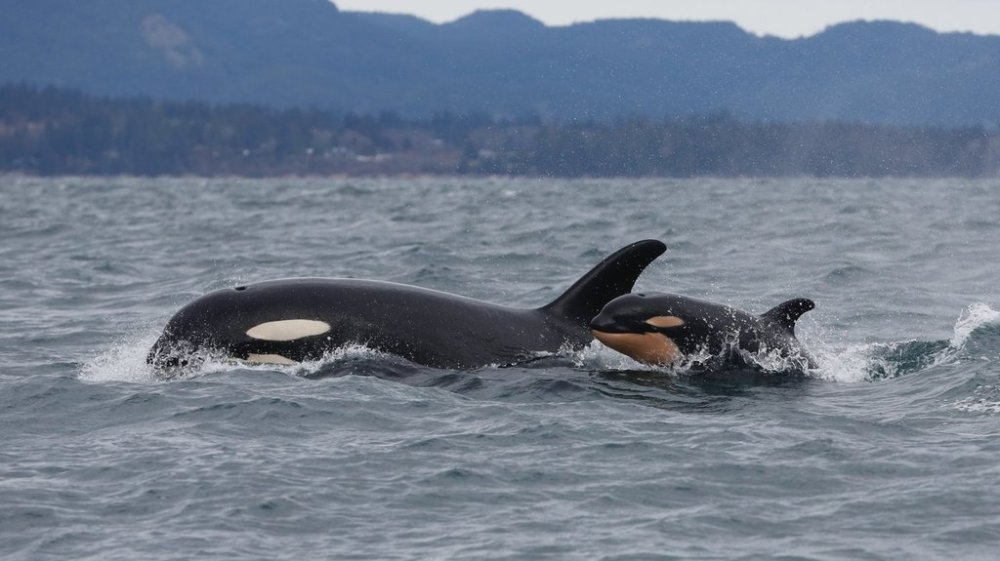Science
Southern Resident Killer Whales Face Slow Decline Amid Threats

The latest survey of the endangered Southern Resident killer whales reveals a concerning trend: the population is plateauing and may be on a gradual path toward extinction without more robust protective measures. According to Michael Weiss, a director with the Center for Whale Research, the findings highlight the urgent need for action to safeguard these iconic marine mammals.
This annual survey, released on October 13, 2025, indicates the overall population stands at 74, which is an increase of just one from the previous year. During the census, researchers observed four births among the three distinct pods of Southern Residents, but only two calves survived. The report also notes the recent disappearance of K26, an adult male from K pod, marking a significant loss for the population that is already struggling with low genetic diversity.
Weiss attributes the decline in numbers to several critical factors, including dwindling populations of Chinook salmon, increased pollution, and the disruptive noise generated by cruise ships, tankers, and freighters in their habitat off the coasts of Washington State and British Columbia. He stated, “We’re not talking about southern residents going extinct in the next five years, but we are talking about a fairly good chance of at least one of the pods being gone within the next 50 years.”
Efforts to restore Chinook salmon habitat—especially freshwater spawning grounds—are essential for the recovery of the Southern Residents, Weiss emphasizes. The survey data paints a stark picture: K pod, with only 14 members, is at its lowest number in the survey’s 50-year history. The reproductive rates within this pod are alarming, as it has not successfully produced a calf since 2022. Weiss adds, “What’s really concerning about K pod is they’re just not reproducing.”
In contrast, J pod is showing some signs of resilience, having recorded a lower mortality rate for adults in recent years. Weiss highlights, “The only pod that’s growing is J pod,” though he notes that this positive trend could change rapidly. The current demographic situation among the Southern Residents raises significant concerns, especially since only 11 immature whales under the age of ten are present, comprising just 15 percent of the population. This is in stark contrast to the northern resident population, where immature orcas make up 47 percent, contributing to their growth.
The Southern Residents are particularly vulnerable due to their reliance on Chinook salmon, which has been declining in number. Weiss explains that these whales often have the “last crack” at salmon migrating from northern waters to Pacific coast rivers, meaning they face heightened competition from fishing fleets and other killer whale populations.
To improve the situation, Weiss advocates for restoring salmon habitats and adjusting fishing practices to minimize the impact on these endangered whales. “If you’re fishing out in the ocean where everything’s mixed up, it’s really hard to avoid taking fish from these declining populations,” he notes.
The challenges posed by urbanization further complicate the Southern Residents’ struggle for survival. Weiss likens their hunting conditions to “trying to find food on a highway,” as they navigate through busy shipping lanes filled with cruise ships and freighters.
As the plight of the Southern Resident killer whales becomes increasingly dire, the call for immediate and effective conservation measures grows louder. The continued decline of this iconic species not only threatens the orcas themselves but also serves as a stark reminder of the broader environmental challenges facing marine ecosystems today.
-

 Education3 months ago
Education3 months agoBrandon University’s Failed $5 Million Project Sparks Oversight Review
-

 Science4 months ago
Science4 months agoMicrosoft Confirms U.S. Law Overrules Canadian Data Sovereignty
-

 Lifestyle3 months ago
Lifestyle3 months agoWinnipeg Celebrates Culinary Creativity During Le Burger Week 2025
-

 Health4 months ago
Health4 months agoMontreal’s Groupe Marcelle Leads Canadian Cosmetic Industry Growth
-

 Technology3 months ago
Technology3 months agoDragon Ball: Sparking! Zero Launching on Switch and Switch 2 This November
-

 Science4 months ago
Science4 months agoTech Innovator Amandipp Singh Transforms Hiring for Disabled
-

 Education3 months ago
Education3 months agoRed River College Launches New Programs to Address Industry Needs
-

 Technology4 months ago
Technology4 months agoGoogle Pixel 10 Pro Fold Specs Unveiled Ahead of Launch
-

 Business3 months ago
Business3 months agoRocket Lab Reports Strong Q2 2025 Revenue Growth and Future Plans
-

 Technology2 months ago
Technology2 months agoDiscord Faces Serious Security Breach Affecting Millions
-

 Education3 months ago
Education3 months agoAlberta Teachers’ Strike: Potential Impacts on Students and Families
-

 Science3 months ago
Science3 months agoChina’s Wukong Spacesuit Sets New Standard for AI in Space
-

 Education3 months ago
Education3 months agoNew SĆIȺNEW̱ SṮEȽIṮḴEȽ Elementary Opens in Langford for 2025/2026 Year
-

 Technology4 months ago
Technology4 months agoWorld of Warcraft Players Buzz Over 19-Quest Bee Challenge
-

 Business4 months ago
Business4 months agoNew Estimates Reveal ChatGPT-5 Energy Use Could Soar
-

 Business3 months ago
Business3 months agoDawson City Residents Rally Around Buy Canadian Movement
-

 Business3 months ago
Business3 months agoBNA Brewing to Open New Bowling Alley in Downtown Penticton
-

 Technology2 months ago
Technology2 months agoHuawei MatePad 12X Redefines Tablet Experience for Professionals
-

 Technology4 months ago
Technology4 months agoFuture Entertainment Launches DDoD with Gameplay Trailer Showcase
-

 Technology4 months ago
Technology4 months agoGlobal Launch of Ragnarok M: Classic Set for September 3, 2025
-

 Technology4 months ago
Technology4 months agoInnovative 140W GaN Travel Adapter Combines Power and Convenience
-

 Science4 months ago
Science4 months agoXi Labs Innovates with New AI Operating System Set for 2025 Launch
-

 Top Stories2 months ago
Top Stories2 months agoBlue Jays Shift José Berríos to Bullpen Ahead of Playoffs
-

 Technology4 months ago
Technology4 months agoNew IDR01 Smart Ring Offers Advanced Sports Tracking for $169










